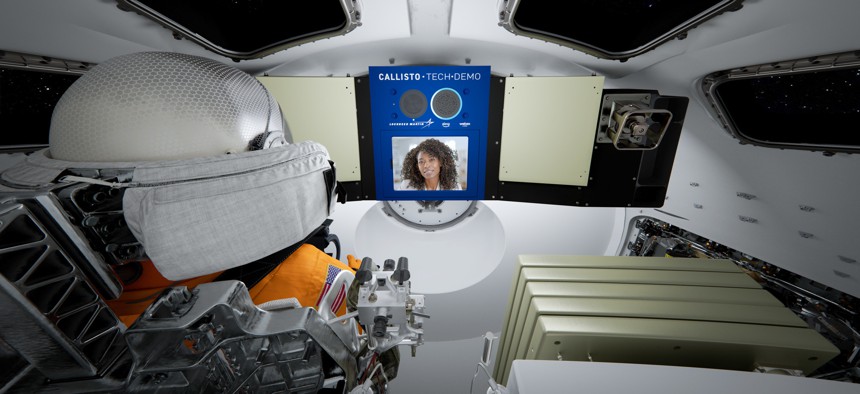Alexa, Webex headed to the moon

An artistic rendering of the Callisto system inside the Orion Spacecraft Lockheed Martin
Custom-built versions of Amazon's Alexa digital voice assistant and Cisco's Webex video collaboration software will be tested on NASA's unmanned Orion spacecraft as it travels to the moon and back.
Amazon's Alexa and Cisco's Webex will be onboard NASA's unmanned Orion spacecraft as it travels to the moon and back, integrated into a device called Callisto.
The industry-funded, purpose-built technology is designed to show how future astronauts could use commercial AI-based voice, video and whiteboard collaboration tools from space to improve efficiency and situational awareness. Callisto will be mounted on Orion's center console and feature a microphone, speakers and a tablet for transmitting video.
Lockheed Martin, which designed and built the Orion spacecraft for NASA, is leading the development and integration of the payload. It worked with Amazon and Cisco to custom-build the hardware and software for testing Alexa and Webex.
Unlike Earth-bound digital assistants and videoconference tools that send data to the cloud, Callisto will rely on a database aboard Orion and use NASA's Deep Space Network for communications, NASA officials said.
Webex will connect the onboard tablet to devices and whiteboards at mission control, demonstrating how its video compression technology can enable high-quality video collaboration over the Deep Space Network using less bandwidth.
New local-processing technology for Alexa will allow it to perform with little or no connectivity to Earth. Alexa will connect directly to Orion's computer to access real-time telemetry data and respond to mission-specific questions through voice commands. For questions that can't be handled onboard, Alexa will use the Deep Space network to contact mission control.
Because Orion will be unmanned, the partners designed a virtual crew experience to allow operators to interact with Callisto and evaluate its performance. Participants at mission control and virtual crew members will ask Alexa questions or issue commands, and cameras inside the spacecraft will record responses from the digital voice assistant and the tablet's video display. Video and audio of the interactions will be transmitted back to Earth throughout the mission so the performance of the onboard systems can be evaluated.
The ideas is that, as astronauts venture deeper into space and latency grows in communications back to earth, Callisto can help crews be more self reliant. It can be considered a “pathfinder” technology for next-generation crews, said Rob Chambers, Lockheed Martin's director of strategy for human spaceflight. Callisto also can process the raw data on the mission and present it to the crew by voice to give them independent situational awareness.
“It’s a new way of interacting not just with the cockpit of a spacecraft, but it could also show up in landers, in habitats or in rovers, and in the future, in Mars spacecraft and landers,” Chambers said.
“I can imagine a future where astronauts can access information on flight status and telemetry … through simple voice commands,” said Howard Hu, deputy Orion program manager at NASA’s Johnson Space Center in Houston. “Orion is already the most advanced spacecraft ever developed to carry astronauts to the Moon, and voice activation technology could take it to the next level by enabling the interactive computer systems of science fiction spaceships to become a reality.”
Orion is currently scheduled to launch in early 2022 from NASA's Kennedy Space Center for a multi-week journey around the Moon and back.






